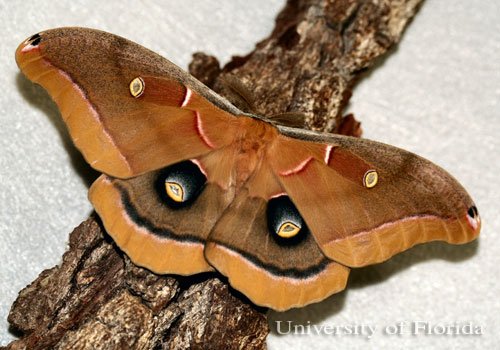August Nature Almanac: Polyphemus Moths Spin Summer Magic
By Stephen Jones, with Ruth Carol Cushman and Scott Severs
August 2023
While strolling along the sidewalk near her west Boulder home in mid-July, Cindy Carlisle came upon a creature that stopped her in her tracks. It wasn't just the alluring tan color of the moth's six-inch-wide wings or its thick, fuzzy body and huge, comb-like antennae. What really captured Cindy's attention were the blue-ringed, transparent eyespots, reminiscent of distant planets, on the moth's wings.
This Polyphemus moth was found lying motionless on a Boulder sidewalk in mid-July. Its somewhat faded colors suggest it has already mated and has just a few hours to live. Photo by Cindy Carlisle.
This striking feature inspired the name Saturnidae for a family of silk moths found on every continent except Antarctica. Polyphemus moths (Antherea polyphemus) are among 8 genera and 15 species documented in North America. The species name derives from the Greek myth of the cyclops Polyphemus.
The prominent eyespots that give Saturnidae their family name are more visible in this striking photo of a recently emerged Polyphemus moth. Photo by David Hall, University of Florida.
Silk moth caterpillars exude a sticky liquid from glands next to their mouth, and the liquid stretches out and hardens into a single long thread that winds around the caterpillar, forming a cocoon. The silk threads from cocoons of Saturnidae, collected one by one by East Asian women, fueled the Chinese textile industry and led to creation of the legendary Silk Road linking East Asia to Western Europe in the second century.
Polyphemus moth caterpillars are striking green and armed with prominent spines. This one was basking in the dawn sunlight at Sawhill Ponds wildlife area in early September. Photo by Stephen Jones.
The giant Polyphemus moth caterpillars are unmistakable, with their striking green bodies and six rows of yellow or orange knobs, known as tubercles, each of which emerges from a red spot. Prominent spines deter predators. The caterpillars hatch out from eggs laid on oaks, willows, maples, birches, and other deciduous trees and shrubs.
After spinning their cocoons, the larvae can transform into adults after about 12 days. Larvae that pupate in late summer or fall overwinter in their large cocoon, which hangs from a branch or may fall to the ground.
The emergent adults mate within a few hours, usually during late evening or early morning. Adults are unable to eat or drink and survive for just a few days. Predators include squirrels, raccoons, mice, woodpeckers, wasps, and ants.
Polyphemus moths, though rarely seen, are not uncommon in Boulder County. Highest numbers have been reported to iNaturalist from mid-June through mid-September. The other large Saturnidid commonly seen locally, the Columbia silk moth (Hyalophora columbia), typically emerges in late spring and early summer, so if you see a giant moth with prominent eyespots in late summer, it's most likely a polyphemus moth.
Columbia silk moths also occur in Boulder County, but they typically emerge in late spring or very early summer. Photo by Leslie Larson.
Other August Events
Monarch butterflies descended from adults who migrated north to Colorado during May and June mate and lay eggs on milkweed plants. Their offspring will comprise part of the autumn population that will fly all the way south to the high mountains of Michoacán to overwinter as adults. In late July, we counted a dozen monarchs along the South Boulder Creek trail originating on the west side of SH 93 south of Boulder.
Our abundant late spring and early summer precipitation (more than 17 inches from May-July in areas of South Boulder) promises a memorable mushroom season throughout Boulder County. Although it's legal to gather mushrooms on forest service lands (though not on open space lands), please do so judiciously, as overharvesting by commercial mushroomers has contributed to diminished numbers of some edible species.
Migrating Pinyon Jays and Sage Thrashers gather in Dowdy Draw and other north-facing foothills canyons.
August is also gentian month. Look for bottle gentians in prairie and foothills grasslands and for subalpine gentians above treeline.
Arctic gentians (Gentianodes algida) bloom above treeline throughout August and September. Photo by Stephen Jones.





